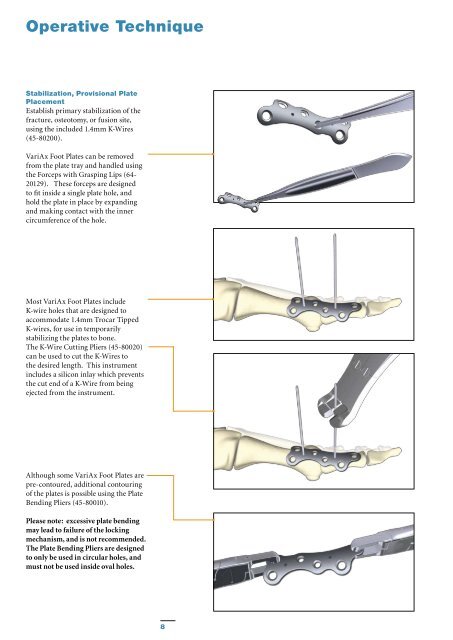Variax foot locking plate system - Stryker
Variax foot locking plate system - Stryker Variax foot locking plate system - Stryker
Operative Technique Stabilization, Provisional Plate Placement Establish primary stabilization of the fracture, osteotomy, or fusion site, using the included 1.4mm K-Wires (45-80200). VariAx Foot Plates can be removed from the plate tray and handled using the Forceps with Grasping Lips (64- 20129). These forceps are designed to fit inside a single plate hole, and hold the plate in place by expanding and making contact with the inner circumference of the hole. Most VariAx Foot Plates include K-wire holes that are designed to accommodate 1.4mm Trocar Tipped K-wires, for use in temporarily stabilizing the plates to bone. The K-Wire Cutting Pliers (45-80020) can be used to cut the K-Wires to the desired length. This instrument includes a silicon inlay which prevents the cut end of a K-Wire from being ejected from the instrument. Although some VariAx Foot Plates are pre-contoured, additional contouring of the plates is possible using the Plate Bending Pliers (45-80010). Please note: excessive plate bending may lead to failure of the locking mechanism, and is not recommended. The Plate Bending Pliers are designed to only be used in circular holes, and must not be used inside oval holes. 8
Operative Technique Plate Hole Configurations Important: 3.5 mm 1. Each round screw hole in a VariAx Foot Plate is designed to accomodate a specific size of screw - the smaller holes accomodate 2.7mm screws, and the larger holes accomodate 3.5mm screws. These screws and holes are NOT interchangeable - a 3.5mm screw must not be used in a 2.7mm screw hole, and a 2.7mm screw must not be used in a 3.5mm screw hole. 2.7 mm no lip compression hole lip lip compression hole no lip 2. Some VariAx Foot Plates include oval locking compression holes, which are designed to accomodate a specific size of screw - the smaller oval holes accomodate 2.7mm screws, and the larger oval holes accomodate 3.5mm screws. These screws and holes are NOT interchangeable - a 3.5mm screw must not be used in a 2.7mm compression hole, and a 2.7mm screw must not be used in a 3.5mm compression hole. The oval holes allow for the active compression of different bone segments along the long axis of an oval hole. In a compression hole, a drill hole can be created in an eccentric position in the part of the oval hole that has no lip. As the screw is tightened, the screwhead glides into the area of the hole that has a lip. If a locking screw is used, the screw can then be locked into the plate in a single step. Please note: If the complete compression of two bone fragments takes place before a locking screw has been able to fully glide into the area of an oval locking hole that has a lip, locking may not be possible. 9
- Page 1 and 2: VariAx Foot Locking Plate System Op
- Page 3 and 4: Introduction The VariAx Foot Lockin
- Page 5 and 6: Overview Plate Options T-Plate Curv
- Page 7: Operative Technique The Operative T
- Page 11 and 12: Operative Technique Preparation for
- Page 13 and 14: Operative Technique Screw Insertion
- Page 15 and 16: Operative Technique Final Tightenin
- Page 17 and 18: Ordering Information 3.5mm LOCKING
- Page 19 and 20: Ordering Information PLATES Quantit
- Page 21 and 22: Ordering Information WASHERS Quanti
- Page 23 and 24: Notes 23
Operative Technique<br />
Stabilization, Provisional Plate<br />
Placement<br />
Establish primary stabilization of the<br />
fracture, osteotomy, or fusion site,<br />
using the included 1.4mm K-Wires<br />
(45-80200).<br />
VariAx Foot Plates can be removed<br />
from the <strong>plate</strong> tray and handled using<br />
the Forceps with Grasping Lips (64-<br />
20129). These forceps are designed<br />
to fit inside a single <strong>plate</strong> hole, and<br />
hold the <strong>plate</strong> in place by expanding<br />
and making contact with the inner<br />
circumference of the hole.<br />
Most VariAx Foot Plates include<br />
K-wire holes that are designed to<br />
accommodate 1.4mm Trocar Tipped<br />
K-wires, for use in temporarily<br />
stabilizing the <strong>plate</strong>s to bone.<br />
The K-Wire Cutting Pliers (45-80020)<br />
can be used to cut the K-Wires to<br />
the desired length. This instrument<br />
includes a silicon inlay which prevents<br />
the cut end of a K-Wire from being<br />
ejected from the instrument.<br />
Although some VariAx Foot Plates are<br />
pre-contoured, additional contouring<br />
of the <strong>plate</strong>s is possible using the Plate<br />
Bending Pliers (45-80010).<br />
Please note: excessive <strong>plate</strong> bending<br />
may lead to failure of the <strong>locking</strong><br />
mechanism, and is not recommended.<br />
The Plate Bending Pliers are designed<br />
to only be used in circular holes, and<br />
must not be used inside oval holes.<br />
8



